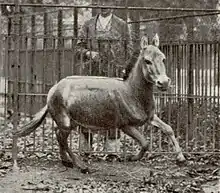Syrian wild ass
The Syrian wild ass (Equus hemionus hemippus), less commonly known as a hemippe,[2] an achdari,[3][4] or a Mesopotamian or Syrian onager,[5] is an extinct subspecies of onager native to the Arabian peninsula and surrounding areas. It ranged across present-day Iraq, Palestine, Israel, Iran, Jordan, Saudi Arabia, Syria, and Turkey.
| Syrian wild ass | |
|---|---|
 | |
| A Syrian wild ass in London Zoo, 1872 | |
| Scientific classification | |
| Kingdom: | Animalia |
| Phylum: | Chordata |
| Class: | Mammalia |
| Order: | Perissodactyla |
| Family: | Equidae |
| Genus: | Equus |
| Species: | |
| Subspecies: | †E. h. hemippus |
| Trinomial name | |
| Equus hemionus hemippus I. Geoffroy, 1855 | |
| Synonyms | |
|
Equus hemionus syriacus | |
Description
The Syrian wild ass, only one metre high at its shoulder,[6] was the smallest equine, and could not be domesticated.[7] Its coloring changed with the seasons — a tawny olive coat for the summer months, and pale sandy yellow for the winter.[6][8] It was known, like other onagers, to be untameable, and was compared to a thoroughbred horse for its beauty and strength.[7]
Distribution and habitat

.jpg.webp)
The Syrian wild ass lived in deserts, semi-deserts, arid grasslands and mountain steppes. Native to West Asia, they were found in Israel, Palestine, Jordan, Iran, Turkey, Syria, Saudi Arabia and Iraq.
Ecology and behavior
Diet
The Syrian wild ass was a grazer. It fed on grass, herbs, leaves, shrubs and tree branches.
Predation
Syrian wild asses were preyed upon by Asiatic lions,[9] Arabian leopards, striped hyenas, Syrian brown bears, Arabian wolves, and Caspian tigers. Asiatic cheetahs and golden jackals may have also preyed on foals.
History
Xenophon of Athens mentions Syrian wild asses in his Anabasis. He reports that they were the most common of animals encountered in Syria; in addition to ostriches, bustards, and gazelles.
Xenophon states that horsemen would occasionally chase the asses, with the asses easily able to outrun the horses. He said that asses would only run a short distance ahead of the horses before stopping, waiting for the horses to get closer, and then running ahead yet again. He described the asses as impossible to catch without careful planning.
A further piece of information given by Xenophon is that the meat of the asses tasted like a more tender version of venison.
European travelers in the Middle East during the 15th and 16th centuries reported seeing large herds.[10] However, its numbers began to drop precipitously during the 18th and 19th centuries due to overhunting, and its existence was further imperiled by the regional upheaval of World War I. The last known wild specimen was fatally shot in 1927 at al Ghams near the Azraq oasis in Jordan, and the last captive specimen died the same year at the Tiergarten Schönbrunn, in Vienna.[11]
Restoration
After the extinction of the Syrian wild ass, the Persian onager from Iran was chosen as the appropriate subspecies to replace the extinct onagers in the Middle East. The Persian onager was then introduced to the protected areas of Saudi Arabia and Jordan. It was also reintroduced, along with the Turkmenian kulan, to Israel, where they both reproduce wild ass hybrids in the Negev Mountains and the Yotvata Hai-Bar Nature Reserve.
Cultural references
- It is believed this may be the "wild ass" which Ishmael was prophesied to be in Genesis in the Old Testament. References also appear in the Old Testament books of Job, Psalms, Jeremiah and the Deuterocanonical book of Sirach.[10]
- The Qur’an, the main book of Islam, in Surat al-Muddaththir, refers to a scene of humur (Arabic: حُـمـر, 'asses' or 'donkeys') fleeing from a qaswarah (Arabic: قَـسـورة, 'lion'). This was to criticize people who were averse to Muhammad's teachings, such as supporting the welfare of the less wealthy.[9]
Related subspecies
- Mongolian wild ass (khulan), Equus hemionus hemionus
- Turkmenian kulan (kulan), Equus hemionus kulan
- Indian wild ass (khur), Equus hemionus khur
- Persian onager (gur), Equus hemionus onager
References
- Moehlman, P. & Feh, C. (2002). "Equus hemionus ssp. hemippus". IUCN Red List of Threatened Species. 2002.CS1 maint: ref=harv (link)
- "hemippe", Merriam-Webster.com, Merriam-Webster, 2013, retrieved 2013-02-06
- Bowling, Ann T.; Ruvinsky, Anatoly (2000-05-18). The Genetics of the Horse. CABI. ISBN 978-0-85199-925-8.
- Gilbert, Allan S. (2002-01-01). "The Native Fauna of the Ancient Near East". A History of the Animal World in the Ancient Near East: 1–75. doi:10.1163/9789047400912_002. ISBN 9789047400912.
- Valerie Porter, Lawrence Alderson, Stephen J.G. Hall, D. Phillip Sponenberg (2016). Mason's World Encyclopedia of Livestock Breeds and Breeding. CABI. p. 48. ISBN 9781845934668.CS1 maint: multiple names: authors list (link)
- Harper, Francis (1945), "Syrian Wild Ass", Extinct and Vanishing Mammals of the Old World, New York: American Committee for International Wild Life Protection, pp. 367–371, hdl:2027/mdp.39015023915971, LCCN 46000560, retrieved 2013-02-07
- Samuel Sidney (1893). The Book of the Horse. Cassell & Co. Ltd. p. 180.
- Mazin B. Qumsiyeh (1996). Mammals of the Holy Land. Texas Tech University Press. p. 191. ISBN 0-89672-364-X.
syrian wild ass.
- Quran 74:41–51
- G. Johannes Botterweck; Helmer Ringgren & Heinz-Josef Fabry (2003). Theological Dictionary of the Old Testament, Volume 12. Wm. B. Eerdmans Publishing Company. pp. 73–76. ISBN 0-8028-2336-X.
- Peter Maas. "Equus hemionus hemippus". The Extinction Website. Archived from the original on 2010-05-06. Retrieved 2009-11-20.
